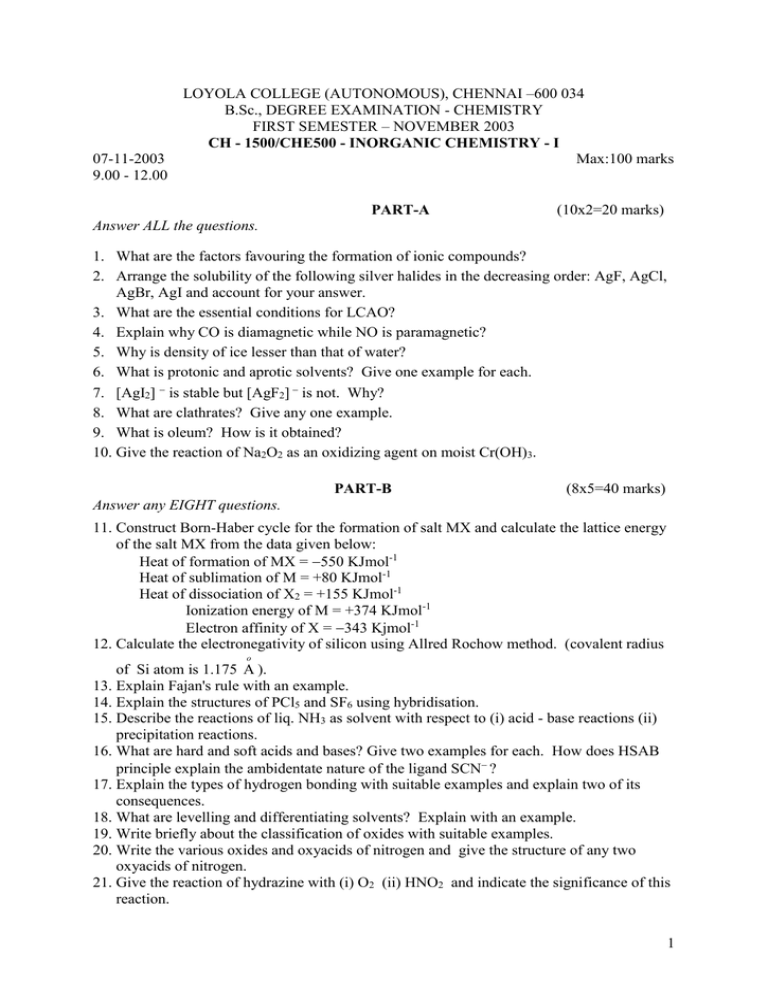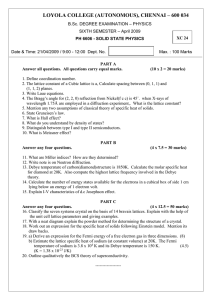LOYOLA COLLEGE (AUTONOMOUS), CHENNAI –600 034 B.Sc., DEGREE EXAMINATION - CHEMISTRY
advertisement

07-11-2003 9.00 - 12.00 LOYOLA COLLEGE (AUTONOMOUS), CHENNAI –600 034 B.Sc., DEGREE EXAMINATION - CHEMISTRY FIRST SEMESTER – NOVEMBER 2003 CH - 1500/CHE500 - INORGANIC CHEMISTRY - I Max:100 marks PART-A (10x2=20 marks) Answer ALL the questions. 1. What are the factors favouring the formation of ionic compounds? 2. Arrange the solubility of the following silver halides in the decreasing order: AgF, AgCl, AgBr, AgI and account for your answer. 3. What are the essential conditions for LCAO? 4. Explain why CO is diamagnetic while NO is paramagnetic? 5. Why is density of ice lesser than that of water? 6. What is protonic and aprotic solvents? Give one example for each. 7. [AgI2] is stable but [AgF2] is not. Why? 8. What are clathrates? Give any one example. 9. What is oleum? How is it obtained? 10. Give the reaction of Na2O2 as an oxidizing agent on moist Cr(OH)3. PART-B (8x5=40 marks) Answer any EIGHT questions. 11. Construct Born-Haber cycle for the formation of salt MX and calculate the lattice energy of the salt MX from the data given below: Heat of formation of MX = 550 KJmol-1 Heat of sublimation of M = +80 KJmol-1 Heat of dissociation of X2 = +155 KJmol-1 Ionization energy of M = +374 KJmol-1 Electron affinity of X = 343 Kjmol-1 12. Calculate the electronegativity of silicon using Allred Rochow method. (covalent radius o of Si atom is 1.175 A ). 13. Explain Fajan's rule with an example. 14. Explain the structures of PCl5 and SF6 using hybridisation. 15. Describe the reactions of liq. NH3 as solvent with respect to (i) acid - base reactions (ii) precipitation reactions. 16. What are hard and soft acids and bases? Give two examples for each. How does HSAB principle explain the ambidentate nature of the ligand SCN ? 17. Explain the types of hydrogen bonding with suitable examples and explain two of its consequences. 18. What are levelling and differentiating solvents? Explain with an example. 19. Write briefly about the classification of oxides with suitable examples. 20. Write the various oxides and oxyacids of nitrogen and give the structure of any two oxyacids of nitrogen. 21. Give the reaction of hydrazine with (i) O2 (ii) HNO2 and indicate the significance of this reaction. 1 PART-C (4x10=40 marks) Answer any FOUR questions. 22. Define lattice energy. How is lattice energy calculated theoretically? What are the factors that affect lattice energy? 23. Explain the postulates of VSEPR theory with special reference to (i) ClF3 (ii) NH3. 24. Construct molecular orbital diagram for O2 molecule and hence discuss the relative stabilities of O2, O 2 , O 2 and O2 2+. 25. Explain band theory as applicable to metals. 26. Explain i) Similarities among nitrogen group elements ii) Differences between nitrogen and other members of the family 27. a) Explain any two methods of estimating H2O2. b) How is the structure of H2O2 established? 2





